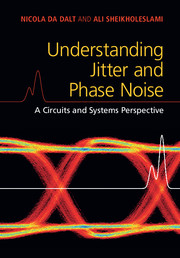Book contents
- Frontmatter
- Dedication
- Contents
- Preface
- Acknowledgments
- 1 Introduction to Jitter
- 2 Basics of Jitter
- 3 Jitter and Phase Noise
- 4 Jitter and Phase Noise in Circuits
- 5 Effects of Jitter in Synchronous Digital Circuits
- 6 Effects of Jitter on Data Converters
- 7 Effects of Jitter in Wireline Applications
- 8 Phase Noise in Wireless Applications
- 9 Advanced Concepts on Jitter and Phase Noise
- 10 Numerical Methods
- Appendix A Review of Random Variables and Processes
- Appendix B Matlab Code for Jitter Generation and Analysis
- Bibliography
- Index
8 - Phase Noise in Wireless Applications
Published online by Cambridge University Press: 19 February 2018
- Frontmatter
- Dedication
- Contents
- Preface
- Acknowledgments
- 1 Introduction to Jitter
- 2 Basics of Jitter
- 3 Jitter and Phase Noise
- 4 Jitter and Phase Noise in Circuits
- 5 Effects of Jitter in Synchronous Digital Circuits
- 6 Effects of Jitter on Data Converters
- 7 Effects of Jitter in Wireline Applications
- 8 Phase Noise in Wireless Applications
- 9 Advanced Concepts on Jitter and Phase Noise
- 10 Numerical Methods
- Appendix A Review of Random Variables and Processes
- Appendix B Matlab Code for Jitter Generation and Analysis
- Bibliography
- Index
Summary
A wireless transceiver typically uses a PLL at the transmitter to up-convert a baseband signal to an RF frequency and uses another PLL at the receiver to down-convert the RF signal back to the baseband. Depending on the quality of the PLL clock, which is often measured by its phase noise, the process of up-conversion and down-conversion produces unwanted signals which often interfere with signals in adjacent channels and deteriorate the SNR at the receiver. In this chapter, we first provide a brief background on the transmitter and receiver concepts, and then discuss the impact of PLL phase noise on transceiver performance.
Basics of Wireless Transceivers
Figure 8.1(a) shows the block diagram of a simplified wireless transmitter, in which a baseband signal is up-converted to an RF frequency in a two-step process: first to an intermediate frequency (IF), and then to an RF frequency, using a local oscillator (inside a PLL). The RF signal is then fed to a bandpass filter (BPF) followed by a power amplifier (PA) and the antenna. If the oscillator produces a pure single tone, the up-converted signal will simply contain the baseband signal translated (shifted) in frequency to fRF. If the baseband signal has a bandwidth of B, the RF signal will have a bandwidth of 2B, as shown in Figure 8.1(b). However, due to the phase noise of the oscillator, the up-converted signal will also contain frequency content outside the 2B bandwidth, which may contribute to noise in adjacent receiver channels. The BPF allows the signal and the noise content within the 2B bandwidth to pass but attenuates the phase noise and other noise content that lie outside the 2B bandwidth. The PA amplifies the power of the RF signal so as to extend its reach to the intended receivers.
A simplified block diagram of a wireless receiver is shown in Figure 8.2(a). The received signal from the antenna is first filtered by an off-chip surface acoustic wave (SAW) filter, then passed to a low noise amplifier (LNA), and subsequently to a mixer that down-converts the RF signal either to an intermediate frequency (IF) or directly to DC for further filtering.
- Type
- Chapter
- Information
- Understanding Jitter and Phase NoiseA Circuits and Systems Perspective, pp. 174 - 182Publisher: Cambridge University PressPrint publication year: 2018



